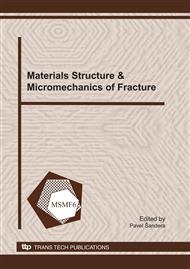p.523
p.527
p.531
p.535
p.539
p.543
p.548
p.552
p.556
An Enhanced Local Approach Model for the Assessment of Brittle Fracture Based on Micromechanical Investigations
Abstract:
The objective of the present study is the development of a micromechanically based probabilistic model for the assessment of the cleavage fracture probability of ferritic steels. Brittle fracture of ferritic steels is a probabilistic process, triggered by the failure of randomly distributed brittle particles. These particles fracture due to plastic deformation of the surrounding matrix, resulting in the nucleation of micro-cracks. Once nucleated, the local stress state controls the possible instability of the defects. In this context, the local stress-triaxiality is assumed to govern the blunting of freshly nucleated micro-defects. The local approach models available in literature account for the above-mentioned correlations only in a simplified manner. Based on Representative Volume Elements (RVE) of the microstructure, accounting for the grain-structure as well as for the brittle particles, the cleavage initiation process was modelled in order to investigate the relevant parameters and their interactions. The RVE’s were loaded according to the local mechanical field quantities determined numerically for a variety of specimen types at the cleavage-origins. Thus, the behaviour of the particles against the micromechanical conditions could be specified, resulting in a better understanding of the processes at cleavage fracture initiation. Based on the results, an enhanced probabilistic cleavage model is proposed.
Info:
Periodical:
Pages:
539-542
Citation:
Online since:
January 2011
Authors:
Price:
Сopyright:
© 2011 Trans Tech Publications Ltd. All Rights Reserved
Share:
Citation:


